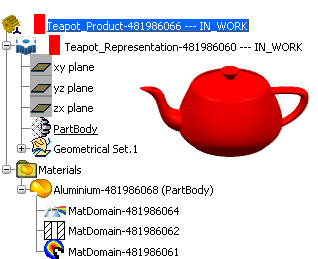Specify the working context by double-clicking a
product reference in the specification
tree.
In the Compass, click East:Links and Knowledge  .
.
By default, Standard : Update & Links status information appears in the compass label. See East Quadrant: Links and Knowledge.
Select the Core material definition option to display information related to the core material definition.
The Core material definition label is displayed. V6 applies a specific color shading to the product structure that indicates the following situations.

 Material definition complete: Specifies three possible cases:
Material definition complete: Specifies three possible cases:
- A core material is applied to the product reference to which
belong 3D shape representations.
- A core material is applied to 3D shape representations in the product structure.
- A core material is applied to all features directly underneath 3D shape representations in the product structure.
 Material definition incomplete: Indicates that a product reference, 3D shape representations, and at a minimum one of the features underneath the 3D shape representations do not have a core material applied in the considered product structure.
Material definition incomplete: Indicates that a product reference, 3D shape representations, and at a minimum one of the features underneath the 3D shape representations do not have a core material applied in the considered product structure.  Undetermined: Identifies 3D shape representations in the product structure for which it is not possible to determine if the material definition is complete.
Undetermined: Identifies 3D shape representations in the product structure for which it is not possible to determine if the material definition is complete.
The color shading status is visible both in the specification tree and in the model geometry. In the specification tree the color shading status is a colored rectangle.

Notes:
- In the specification tree, the color shading priority rule is enforced with respect to a worst to best status scheme. Red shading takes priority over orange, and so forth.
- A product element turns green only if all the elements directly underneath that product are green.
Click a geometry either from the specification tree or the model geometry.
The related information for the selected geometry is displayed and provides a detailed status. It includes the relevant product structure elements—products and representations— that contain the selected geometry, the current core material information with specific icons  and
and  , and specifies if a core material needs to be applied
, and specifies if a core material needs to be applied  or a 3D shape representation needs to be loaded
or a 3D shape representation needs to be loaded  .
.
The following figures illustrate a red shading status (top) and an orange shading status (bottom):


To resolve the issues that appear in the detailed status, do the following:
- Click
 in the line of interest to apply the missing core material.
in the line of interest to apply the missing core material.
- Click
 to load the 3D shape representation and update the representation status.
to load the 3D shape representation and update the representation status.
The material definition is complete. The color shading status is updated to reflect the current core material information; the core material icon changes to indicate a core material is applied accordingly  .
.
![]() .
.